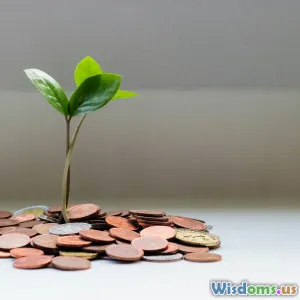
Step by Step Guide to Getting Started With Green Finance
8 min read A comprehensive, actionable guide to begin your journey in green finance and drive sustainable impact. (0 Reviews)
Step by Step Guide to Getting Started With Green Finance
Introduction
Green finance is revolutionizing the way individuals, businesses, and governments think about financial decisions tied to the environment. As climate change accelerates and environmental challenges become increasingly urgent, green finance emerges as a powerful tool that aligns capital flow with sustainable development goals. But where does one begin in this dynamic and complex field? This guide breaks down the essential steps into clear, actionable insights designed to spark your involvement in green finance, whether you're an investor, entrepreneur, policymaker, or curious learner.
“The transition to a low-carbon economy isn’t just an environmental imperative — it’s a staggering economic opportunity.” - Mark Carney, UN Special Envoy for Climate Action and Finance
Understanding Green Finance: The Foundation
Before diving into practical steps, it's critical to grasp what green finance truly entails. It refers to the use of financial instruments and investments that support projects and initiatives with environmental benefits. The goal is to channel money toward cleaner technologies, sustainable infrastructure, renewable energy, climate adaptation, and other eco-friendly efforts.
Key Components of Green Finance
-
Green Bonds: Debt securities specifically earmarked for climate and environmental projects. For example, in 2020, Apple issued a $2.2 billion green bond to fund renewable energy.
-
Sustainable Investing: Incorporating ESG (Environmental, Social, Governance) criteria into investment decisions to minimize environmental harm and promote sustainability.
-
Climate Risk Assessments: Analyzing how investments or projects will fare under climate change scenarios.
Understanding these components sets the groundwork for participating effectively.
Step 1: Educate Yourself on Green Finance Principles
Learning is the first critical step. Read foundational literature, attend webinars, and follow leading institutions shaping the field, such as the Climate Bonds Initiative or the Green Finance Platform by the UN Environment Programme.
Recommended Resources
-
Books: "Sustainable Investing" by Cary Krosinsky, "Climate Finance: Theory and Practice" by Petra K. Tschakert
-
Websites: PRI (Principles for Responsible Investment), Green Climate Fund
-
Courses: Coursera's "Climate Change and Financial Markets"
Gaining a strong conceptual understanding prepares you for informed decision-making.
Step 2: Assess Your Financial Goals and Values
Green finance is not just about profits; it's about aligning your financial actions with environmental impact. Reflect on your priorities:
- Do you want your investments to generate positive environmental outcomes?
- Are you willing to accept trade-offs between risk, return, and impact?
- Are you interested in direct project financing, or prefer investing via funds or bonds?
This introspection will shape your approach and strategy.
Step 3: Explore Green Financial Products
Green finance offers a variety of financial instruments:\
3.1 Green Bonds
These have grown exponentially — about $500 billion in cumulative issuance by 2021 globally. Major issuers include governments, municipalities, and corporations.
Example: The European Investment Bank, a pioneer in green bonds, raised €1 billion in 2007 to finance renewable energy and energy efficiency.
3.2 ESG Mutual Funds and ETFs
Many funds integrate sustainability criteria, making them accessible avenues for retail investors. For example, the iShares Global Clean Energy ETF provides exposure to leading clean energy stocks.
3.3 Green Loans and Sustainability-linked Loans
Companies can access loans with favorable terms if they meet sustainability targets — an innovative financing tool balancing risk with environmental performance.
Step 4: Start Small With Sustainable Investments
For individual investors:
- Begin by adjusting your portfolio with ESG-focused ETFs or green mutual funds.
- Use online platforms that specialize in sustainable investing to screen companies according to environmental criteria.
Example: Platforms like OpenInvest offer the ability to customize investments aligned with climate impact.
For businesses or entrepreneurs:
- Evaluate your organization's environmental footprint.
- Seek sustainability financing to upgrade equipment or shift to renewable energy.
Step 5: Understand and Manage Risks
Like traditional finance, green finance involves risks but also specific ones related to transitions and physical climate impacts.
Transition Risks
These arise from policy changes, technology shifts, or market preferences toward low-carbon economies. Organizations ignoring these may face stranded assets or regulatory penalties.
Physical Risks
Damage to assets from climate events like floods or hurricanes can disrupt operations and impact investments.
Organizations like the Task Force on Climate-related Financial Disclosures (TCFD) provide frameworks to assess these risks.
Step 6: Engage With Regulatory and Reporting Standards
Green finance is increasingly regulated to ensure transparency and impact credibility.
Key Frameworks
- Sustainable Finance Disclosure Regulation (SFDR): An EU regulation increasing transparency on how sustainability risks are integrated.
- Green Bond Principles (GBP): Voluntary guidelines that promote transparency and disclosure in green bond issuance.
- Taxonomy for Sustainable Activities: Defining what counts as environmentally sustainable within the EU.
Participation involves understanding compliance and reporting obligations.
Step 7: Collaborate and Network
Green finance thrives with collaboration across sectors.
- Join forums like the Green Finance Leadership Network or local sustainable finance communities.
- Partner with NGOs, consultancies, and academic institutions to stay updated and leverage expertise.
Real-World Insight: Case of Renewable Energy Project Financing
Consider a solar power startup seeking funding:
- They begin by certifying their project as green under recognized standards.
- They tap into green bonds or blended finance mechanisms combining public and private funds.
- Investors attracted by credible impact and projected returns participate.
- Throughout, transparent reporting on environmental impact fosters trust.
Such projects exemplify the tangible benefits of stepping into green finance.
Conclusion
Green finance is more than a trend; it’s a critical movement towards aligning financial growth with environmental stewardship. Starting in this sector requires education, goal-setting, understanding financial tools, and managing risks smartly. By acting on this step-by-step guide, you empower yourself to be part of driving the global green transition – proving that finance can be a formidable force for the planet's future.
Takeaway: Your involvement in green finance can help unlock sustainable growth, reduce environmental risks, and lead to resilient communities. Begin your journey today with informed actions and purposeful choices.
References:
- Climate Bonds Initiative (https://www.climatebonds.net)
- UNEP Finance Initiative (https://www.unepfi.org)
- Mark Carney’s speeches and publications on climate finance
- TCFD Recommendations (https://www.fsb-tcfd.org)
Word Count: 1890
Rate the Post
User Reviews
Popular Posts



















